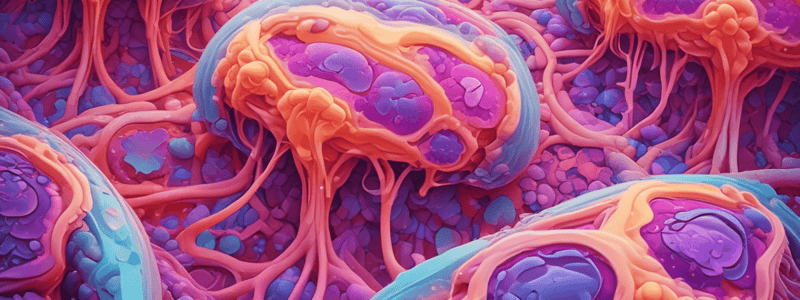Podcast
Questions and Answers
Which of the following is a characteristic of reversible injury due to ischemia in renal tubular epithelium?
Which of the following is a characteristic of reversible injury due to ischemia in renal tubular epithelium?
- Ruptured cytoplasmic membranes
- Nuclear shrinkage and increased basophilia
- Swelling and eosinophilia (correct)
- Karyolysis
Which nuclear change is associated with irreversible injury (necrosis) in renal tubular epithelium?
Which nuclear change is associated with irreversible injury (necrosis) in renal tubular epithelium?
- Intact plasma membranes
- Karyorrhexis (correct)
- Both A and B
- Distinct nuclear euchromatin and heterochromatin
In terms of reversible injury due to ischemia, what is a common feature observed in the cytoplasm of renal tubular epithelium?
In terms of reversible injury due to ischemia, what is a common feature observed in the cytoplasm of renal tubular epithelium?
- Swelling and eosinophilia (correct)
- Ruptured plasma membranes
- Nuclear shrinkage
- Karyolysis
What is the primary ultrastructural change observed in proximal tubular cells during reversible ischemic injury?
What is the primary ultrastructural change observed in proximal tubular cells during reversible ischemic injury?
Which of the following is a characteristic of irreversible ischemic injury in renal tubular epithelium?
Which of the following is a characteristic of irreversible ischemic injury in renal tubular epithelium?
What is the primary cause of reversible fatty change (steatosis) in the liver?
What is the primary cause of reversible fatty change (steatosis) in the liver?
What is the characteristic histological feature of reversible hydropic change in the skin?
What is the characteristic histological feature of reversible hydropic change in the skin?
Steatosis is a medical condition characterized by the accumulation of sugar in the liver cells.
Steatosis is a medical condition characterized by the accumulation of sugar in the liver cells.
What is the primary source of the enzymes responsible for the digestion of necrotic cells?
What is the primary source of the enzymes responsible for the digestion of necrotic cells?
Which of the following is NOT a characteristic morphological change observed in necrotic cells?
Which of the following is NOT a characteristic morphological change observed in necrotic cells?
What is the purpose of the inflammatory reaction that often accompanies necrosis?
What is the purpose of the inflammatory reaction that often accompanies necrosis?
Which of the following statements about myelin figures is correct?
Which of the following statements about myelin figures is correct?
What is the primary reason for the glassy, homogeneous appearance of necrotic cells?
What is the primary reason for the glassy, homogeneous appearance of necrotic cells?
What is the primary mechanism behind the formation of chalky-white deposits in fat necrosis?
What is the primary mechanism behind the formation of chalky-white deposits in fat necrosis?
Which of the following is the primary cause of fat necrosis in the context of acute pancreatitis?
Which of the following is the primary cause of fat necrosis in the context of acute pancreatitis?
What is the microscopic appearance of necrotic fat cells in fat necrosis?
What is the microscopic appearance of necrotic fat cells in fat necrosis?
What is the defining characteristic of the morphologic pattern of fibrinoid necrosis?
What is the defining characteristic of the morphologic pattern of fibrinoid necrosis?
Which of the following is a common clinical condition associated with the development of fibrinoid necrosis?
Which of the following is a common clinical condition associated with the development of fibrinoid necrosis?
Which of the following is a key feature of the morphologic pattern of wet gangrene?
Which of the following is a key feature of the morphologic pattern of wet gangrene?
Which of the following nuclear changes is characterized by nuclear shrinkage and increased basophilia?
Which of the following nuclear changes is characterized by nuclear shrinkage and increased basophilia?
What is the primary mechanism of coagulative necrosis?
What is the primary mechanism of coagulative necrosis?
Which morphologic pattern of necrosis is characterized by profound disruption leading to liquification of tissue?
Which morphologic pattern of necrosis is characterized by profound disruption leading to liquification of tissue?
In which nuclear change does the pyknotic nucleus undergo fragmentation?
In which nuclear change does the pyknotic nucleus undergo fragmentation?
What distinguishes karyolysis from pyknosis?
What distinguishes karyolysis from pyknosis?
Which morphologic pattern of necrosis is associated with a dry, black appearance due to ischemic coagulative necrosis?
Which morphologic pattern of necrosis is associated with a dry, black appearance due to ischemic coagulative necrosis?
What is the term used to describe a wedge-shaped area of necrosis caused by an occluded artery in the kidney?
What is the term used to describe a wedge-shaped area of necrosis caused by an occluded artery in the kidney?
Which type of necrosis is characterized by the complete digestion of dead cells, transforming tissue into a gelatinous mass?
Which type of necrosis is characterized by the complete digestion of dead cells, transforming tissue into a gelatinous mass?
Which of the following conditions is associated with caseous necrosis?
Which of the following conditions is associated with caseous necrosis?
What is the characteristic histopathologic lesion observed in caseous necrosis?
What is the characteristic histopathologic lesion observed in caseous necrosis?
Which organism is most likely to be detected by performing an acid-fast stain on a lesion exhibiting caseous necrosis?
Which organism is most likely to be detected by performing an acid-fast stain on a lesion exhibiting caseous necrosis?
What is the term used to describe necrosis of a body part, typically a leg, that has undergone coagulation necrosis due to ischemia?
What is the term used to describe necrosis of a body part, typically a leg, that has undergone coagulation necrosis due to ischemia?
What is the term used to describe gangrenous necrosis with superimposed infection, resulting in liquefactive necrosis?
What is the term used to describe gangrenous necrosis with superimposed infection, resulting in liquefactive necrosis?
Which of the following statements about coagulative necrosis is correct?
Which of the following statements about coagulative necrosis is correct?
Which type of necrosis is unique to the central nervous system, as opposed to other solid organs?
Which type of necrosis is unique to the central nervous system, as opposed to other solid organs?
Which of the following is NOT a characteristic of gangrenous necrosis?
Which of the following is NOT a characteristic of gangrenous necrosis?



